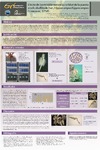Please use this identifier to cite or link to this item:
https://accedacris.ulpgc.es/handle/10553/5852
| Title: | Efecto de los misidáceos en la calidad de la puesta en el caballito de mar, Hippocampus hippocampus (Linnaeus, 1758) | Authors: | Otero-Ferrer, Francisco Molina-Domínguez, Lucía Socorro Cruz, Juan Antonio Herrera-Pérez, Rogelio Fernandez-Palacios, H. Izquierdo, Marisol |
UNESCO Clasification: | 310502 Piscicultura | Keywords: | Misidáceos Caballito de mar Hippocampus hippocampus |
Issue Date: | 2009 | Abstract: | The importance of a suitable feeding in reproduction and spawning quality of teleost fish has been recognized as one of the major ?bottlenecks? in new aquaculture species like seahorses. Mysidacea species has been described as one of the main food for temperate seahorse species (Hippocampus hippocampus and H. guttulatus) in the wild. On the other hand, Artemia has been employed usually as marine food for rearing fish, including seahorses. The aim of this work is to study the effect of two different live preys (Artemia vs Mysis) in spawning quality of H. hippocampus broodstock. The animals were fed two times per day, six times per week. Spawning episodes and larvae quality was recorded. Seahorse fed on mysis showed significantly better results (p<0.05) than Artemia treatment, regarding spawning events, number of offspring?s and size. This fact showed the high potential of mysis as live prey for seahorses or other ornamental species. | URI: | https://accedacris.ulpgc.es/handle/10553/5852 | Source: | XII Congreso Nacional de Acuicultura, Madrid 24-26, Noviembre 2009 | Rights: | by-nc-nd |
| Appears in Collections: | Póster de congreso |
Page view(s)
259
checked on Nov 23, 2024
Download(s)
231
checked on Nov 23, 2024
Google ScholarTM
Check
Share
Export metadata
Items in accedaCRIS are protected by copyright, with all rights reserved, unless otherwise indicated.
